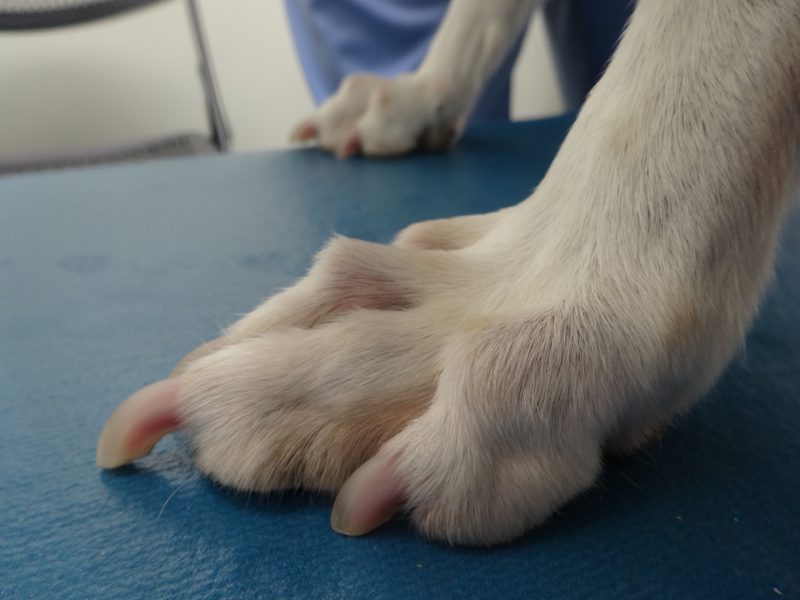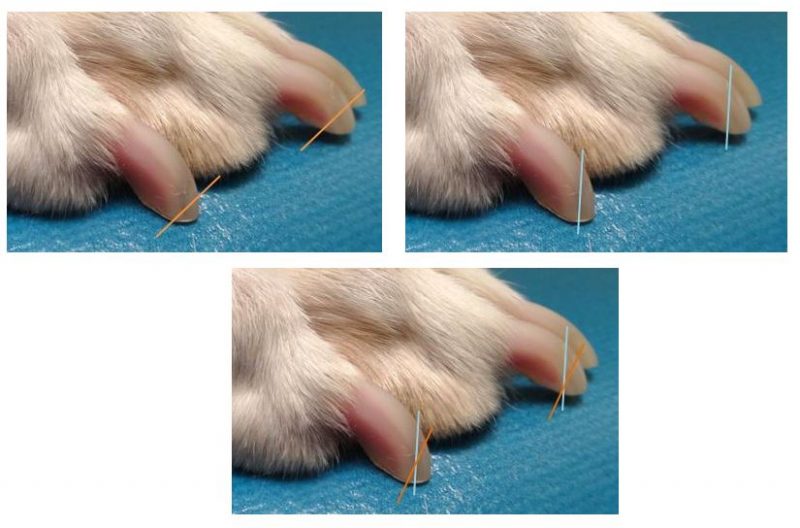All about Those Toes; The Importance of Nail Trims
by Cathryn Adolph, BS, LVT
Feet are awesome! We take our feet for granted, but they are a complex combination of muscles, tendons, ligaments, many small bones, and nerves. They keep us in touch with the ground, propel us forward, maintain balance, and help us brake to avoid collisions. In this blog, we will discuss how to care for the foot and nail trims.
The Dog’s Foot
While humans walk with their feet and toes flat, dogs walk on their toes with the bones held at angles. These angles allow the foot to serve as shock absorbers for the limb and thus prevent the impact from affecting larger joints closer to the body and even the spine. The feet also have many sensory nerve endings that are designed to protect the body from injury. If we were to step into a divot in the grass, the sensory nerves in our feet and ankle sense the sudden and abnormal change in direction and signal the brain to correct the problem. All this happens before we are even consciously aware that we were off balance!
Nail Length
Ideally, a dog’s nails should not touch the ground when they are standing or extend over the pad when the foot is in a relaxed position.

When nails are allowed to grow for too long a duration, the entire nail including the quick grows out too. This changes the angle in which the toe segments (phalanges) are held. In this picture the flat toe is in hyperextension, and the pet can’t flex the toe properly.
This allows enough length left on the nail to allow the dog to engage the ground when necessary.
If the nails are too long the nail can …
- become caught and damaged
- split
- push the toe back into the foot causing pads to not reach the floor
- rotate sideways and cause foot pain
Nail Trims
Nails should be trimmed a minimum of once a month, if not more often. If the quick (blood supply to the nail) is long, trimming once a week will help the quick recede faster. The trim should be at an angle so more of the quick will be exposed to air and cause it to dry out faster.

The orange line demonstrates the traditional line that nails are trimmed, while the blue line is the alternative line. When the lines are drawn on the same picture, you can see how much more nail is able to be trimmed before reaching the quick.
 Traction
Traction
While nails do provide traction, they engage the floor for quick accelerations and direction changes. In normal standing and walking, the pads provide the most traction. I am sure many of us have seen a dog scramble across a slippery floor but not getting anywhere, looking like a cartoon.
All pets will have hair between the toes; however, some breeds will have long hair between the toes. This hair can then cover the pads and reduce a pet’s traction. Keeping the hair trim can prevent slips on hard wood and tile flooring.
Conclusion
The condition of our pet’s nails and pads can affect our pets’ orthopedic health. Nails that are an appropriate length allow the pads to contact the ground, giving the dog the best traction. The resources below have more information about the alternative cut line for nail trims and support groups to help make nail trims less stressful.
Resources
Leslie Woodcock DVM, of Woodcock Veterinary Services, discusses the importance of nail length and how to cut using the alternative cut line.
Nail Maintenance for Dogs Facebook Group, has many resources for dog owners. The files section contains information on desensitizing and counter conditioning nails trims. Also contains files on nail clippers, dremel tools, DIY nail file boards, and how to teach you how to use them.
Dr. Buzby’s Toe Grips are a great tool to help dogs get traction on slippery floors (once nails and hair under the pads are trimmed). These are rubber rings that slide onto the toe, but must be applied after the nails are trimmed. Four Leg Rehabilitation wrote a great review of the toe grips on her June 21, 2015 blog.
References
Carr, DVM, CCRT, B.J., & Zink, DVM, PhD, DACVP, DACVP, DACVSMR, CCRT, CVA, CSMT, C. (March 2017). Nail Care and Dewclaws for the Agility Dog. Clean Run, pp. 51-53.
Garrett, Susan. “How Important Is Cutting Your Dog’s Nails Really?” Online Video Clip. YouTube, 20 August 2013. Web. 29 August 2015.
Gellman, DVM, PhD, K., & Shoemaker, DVM, J. M. (2012). Feet on The Ground. Canine Health Foundation.
Henneman, D. F. (2014, June). The Biomechanics of Toes & Nails. Clean Run, pp. 24-27.
Zink, DVM, PhD, DACVSMR, C. (2009). M. Christine Zink DVM, PhD, DACVSMR. Penn Vet Working Dog Center. Philadelphia.
